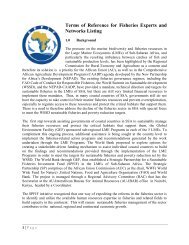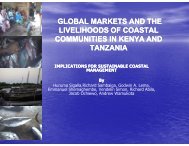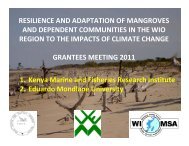Managing Marine Protected Areas Managing Marine Protected Areas
Managing Marine Protected Areas Managing Marine Protected Areas
Managing Marine Protected Areas Managing Marine Protected Areas
Create successful ePaper yourself
Turn your PDF publications into a flip-book with our unique Google optimized e-Paper software.
● Incorporate comments and publish final Plan<br />
(preferably both as a hard copy and electronically)<br />
● Submit plan for approval (the mechanism for this<br />
varies between countries) and disseminate it.<br />
Where an MPA does not have sufficient capacity or<br />
expertise to prepare a Plan, it may be useful to hire a<br />
consultant. Such a person must work closely with MPA<br />
personnel and stakeholders so that when he/she leaves all<br />
involved feel ownership of the Plan and are willing to<br />
implement it.<br />
CONTENT<br />
The Plan may be a single document covering all aspects of<br />
management or a general ‘umbrella’ document. In the<br />
latter case, specific plans are developed separately, such<br />
as a day-to-day operational plan, annual work plans,<br />
detailed zoning plan, business and financial plan, and<br />
visitor plan. These may have different target audiences<br />
and may need to be prepared in different ways. The level<br />
of detail to be included in the plan will be decided by the<br />
site manager and the relevant management agency.<br />
The Plan should present both the stategic and operational<br />
elements of the MPA and clearly link them, be flexible<br />
enough to cater for unforeseen events and interpret<br />
national policies in relation to the MPA, taking into<br />
account obligations under international conventions. It<br />
should identify the assumptions (e.g. adequate funding<br />
and political stability) that have to be made for successful<br />
implementation; these may be beyond the manager’s<br />
control but may have consequences that require<br />
contingencies. Many Plans give too much description;<br />
detailed biological and socio-economic information can be<br />
placed in annexes or a separate volume. Good<br />
presentation, with maps and other visual aids, will help to<br />
ensure the Plan is used. The text should be clear, concise<br />
and accurate. It may be necessary to translate it, or key<br />
sections, into local languages, and prepare a summary for<br />
broader dissemination.<br />
KEY POINTS FOR THE MPA<br />
❑ Ensure that all staff are familiar with and use the<br />
Management Plan, and understand its status (as a<br />
legal document or general guidance).<br />
❑ Revise the Plan at the appropriate intervals,<br />
involving all stakeholders, and ensuring an<br />
objective-oriented approach.<br />
❑ Ensure that the budget allows for preparing and/or<br />
revising the Management Plan, or that special<br />
funding is sought.<br />
❑ Obtain copies of management plans for other<br />
MPAs, both within your country and from other<br />
countries for comparison.<br />
Sources of further information<br />
Amend, S., et al. 2003. Management Plans: concepts and<br />
proposals. Parques Nacionales y Conservacion Ambiental No. 11.<br />
Panama. 114pp. Available from: IUCN Regional Office for<br />
MesoAmerica, Moravia, Apartado Postal 0146-2150, San José, Costa<br />
Rica; www.iucn.org/places/orma; correo@orma.iucn.org<br />
Davey, A.G. 1998. National System Planning for <strong>Protected</strong> <strong>Areas</strong>.<br />
Best Practice <strong>Protected</strong> Area Guidelines Series No. 1, IUCN, Gland,<br />
Switzerland and Cambridge, UK.<br />
Eagles, P.F.J., McCool, S.F. & Haynes, D.A. 2002. Sustainable Tourism<br />
in <strong>Protected</strong> <strong>Areas</strong>: Guidelines for Planning and Management.<br />
IUCN, Gland, Switzerland and Cambridge. 183pp.<br />
Kareko, J. & Siegel, P. 2003. Planning for <strong>Marine</strong> <strong>Protected</strong> <strong>Areas</strong>.<br />
Module 2. p.39-84. In: Francis, J., et al. (eds.) Training for the<br />
Sustainable Management of <strong>Marine</strong> <strong>Protected</strong> <strong>Areas</strong>: a Training<br />
Manual for MPA Managers. CZMC/WIOMSA.<br />
Kelleher, G. 1999. Guidelines for <strong>Marine</strong> <strong>Protected</strong> <strong>Areas</strong>. Best<br />
Practice <strong>Protected</strong> Area Guidelines Series No. 3, IUCN, Gland,<br />
Switzerland and Cambridge, UK. 107pp.<br />
Macleod, P., Leon, P. & Esquivias, P. 2001. Integrated Strategic and<br />
Financial Planning for Non-Governmental Organisatons. TNC/US-<br />
AID. Vol. 3 Resources for Success Series. 64pp.<br />
Thomas, L. & Middleton, J. 2003. Guidelines for Management<br />
Planning of <strong>Protected</strong> <strong>Areas</strong>. Best Practice <strong>Protected</strong> Area Guidelines<br />
Series No. 10, IUCN, Gland, Switzerland and Cambridge, UK. 79pp.<br />
CASE STUDY<br />
Management Plan for Moheli <strong>Marine</strong> Park,<br />
Union des Comores<br />
The decree that established Moheli <strong>Marine</strong> Park requires<br />
that a management plan be prepared. This was done with<br />
support from a UNDP/GEF project and technical<br />
assistance from IUCN. The process took two years and<br />
involved all stakeholders, particularly the 10 villages<br />
involved in collaborative management of the Park. The<br />
process started with a training workshop organised by the<br />
park personnel and ‘eco-gardes’ (village-based rangers).<br />
The objectives were developed through consultations in<br />
the villages and working groups were set up to develop<br />
certain sections of the plan. All aspects of the plan were<br />
developed in consultation including gathering baseline<br />
information, defining the zoning plan, and developing the<br />
regulations and co-management agreements. The<br />
management plan is for five years and will be used to<br />
develop annual work plans and more detailed operational<br />
plans. It was approved by the Management Committee of<br />
the MPA. The contents are as follows:<br />
● Ecological and socio-economic characteristics and<br />
values;<br />
● Threats to the environment and its resources;<br />
● Objectives and strategies to be adopted to ensure<br />
conservation, sustainable use of natural resources,<br />
and the sustainable development of revenue<br />
generating activities;<br />
● Management inputs (management structure, budget<br />
and financial resources, equipment);<br />
● Zonation scheme, regulations, rights of access to<br />
zones and co-management agreements;<br />
● Five year action plan for each objective.<br />
Sheet C3 <strong>Managing</strong> <strong>Marine</strong> <strong>Protected</strong> <strong>Areas</strong>: A TOOLKIT for the Western Indian Ocean






